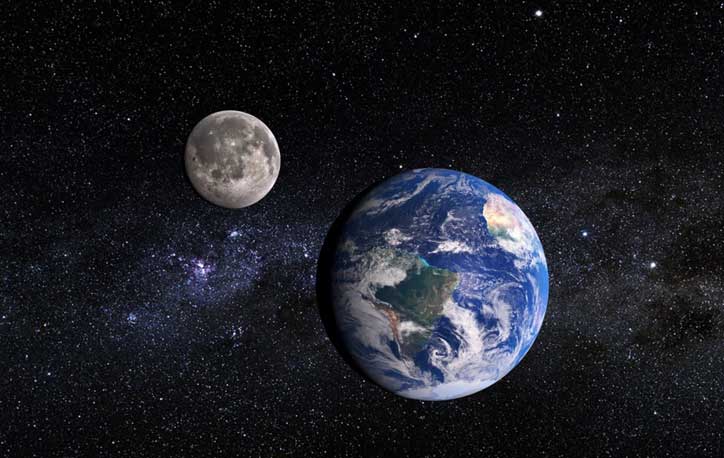 NY:
NY: More than a billion years ago, a day on Earth lasted just 18 hours, a new study reports. The distance from our planet to the moon, scientists say, is one major reason for the extra six hours we have today.
Our faithful rocky companion used to lie far closer to our planet—near enough to alter the way it moves, researchers reported Monday in Proceedings of the National Academy of Sciences.
We sometimes wish days were longer to fit our busy schedules. Luckily, someone up there is listening. No, it’s not some all-powerful deity — I’m referring to our conspicuous, friendly celestial neighbor, the moon. According to a landmark study, a day on Earth lasted only 18 hours about 1.4 billion years ago. As the moon slowly drifts away from Earth, its influence on our planet’s spin around its axis is waning, thereby making days last longer.
“As the moon moves away, the Earth is like a spinning figure skater who slows down as they stretch their arms out,” explains Stephen Meyers, professor of geoscience at the University of Wisconsin-Madison and co-author of the new study published in the Proceedings of the National Academy of Sciences.
Every year, the moon drifts away from Earth at the rate of 3.78cm (1.48in) per year, or at about the same speed at which our fingernails grow. The migration of the Moon away from the Earth is mainly due to the action of the Earth’s tides.
Without the moon, Earth could slow down enough to become unstable, but this would take billions of years and it may never happen at all.
Scientists believe that when Earth and the moon were barely formed some 4.5 billion years ago, days were only five hours long. As the satellite drifted farther away from Earth, days grew longer and this is traceable in the fossil records of some creatures. For instance, the daily growth bands of corals record the number of days that occurred per year in ancient times. By one estimate, days are getting longer at a rate of 19 hours every 4.5 bn years.
Now, using a new method, Meyers and colleagues were able to devise a novel way to calculate the moon's influence on the days on Earth.
The researchers’ statistical method combines astronomy with geological data in order to reverse-engineer Earth’s geological past. Scientist call this method astrochronology.
“One of our ambitions was to use astrochronology to tell time in the most distant past, to develop very ancient geological time scales,” Meyers says. “We want to be able to study rocks that are billions of years old in a way that is comparable to how we study modern geologic processes.”
Variations in Earth’s rotation are called Milankovitch cycles and they determine where sunlight is distributed on Earth, which also determines Earth’s climate rhythms. Such variations are recorded in the rock record and, theoretically, it’s possible to trace Earth’s rotational history back to billions of years in the past.
The challenge lies in the fact that Earth’s behavior, such as its motion around its axis, is determined not just by the tug-of-war between the gravitational forces of Earth and the moon, but also by the influence of the sun and other planets. Even tiny effects can compound to significant proportions over millions and millions of years. So, the farther back in time you try to peek, the less reliable the conclusion is likely to be.
Looking to find a better way to account for the motion of our planetary neighbors, Meyers teamed up Alberto Malinverno, Lamont Research Professor at Columbia, and combined a statistical method designed to deal with uncertainty, called TimeOpt, with astronomical theory, geologic data and a sophisticated statistical approach called Bayesian inversion.
The new approach, called TimeOptMCMC, was tested on rock samples collected from two sites: a 1.4 billion-year-old Xiamaling Formation from Northern China and a 55 million-year-old record from Walvis Ridge.
Using such an approach, Meyers and colleagues assessed variations in Earth’s axis of rotation both in more recent and earlier times, while also addressing uncertainty. This is how they were able to determine the length of the day, and also the distance between Earth and the moon, for various periods.
The study’s approach was previously vetted by a team at Lamont-Doherty that employed a rock formation in Arizona to assess Earth’s orbital fluctuations from nearly circular to more elliptical on a 405,000-year cycle. Elsewhere, researchers in New Zealand who worked closely with Meyers studied how changes in Earth’s orbit and rotation around its axis impacted the cycles of evolution and extinction in marine organisms called graptoloids, going back 450 million years.
 NY: More than a billion years ago, a day on Earth lasted just 18 hours, a new study reports. The distance from our planet to the moon, scientists say, is one major reason for the extra six hours we have today.
NY: More than a billion years ago, a day on Earth lasted just 18 hours, a new study reports. The distance from our planet to the moon, scientists say, is one major reason for the extra six hours we have today.